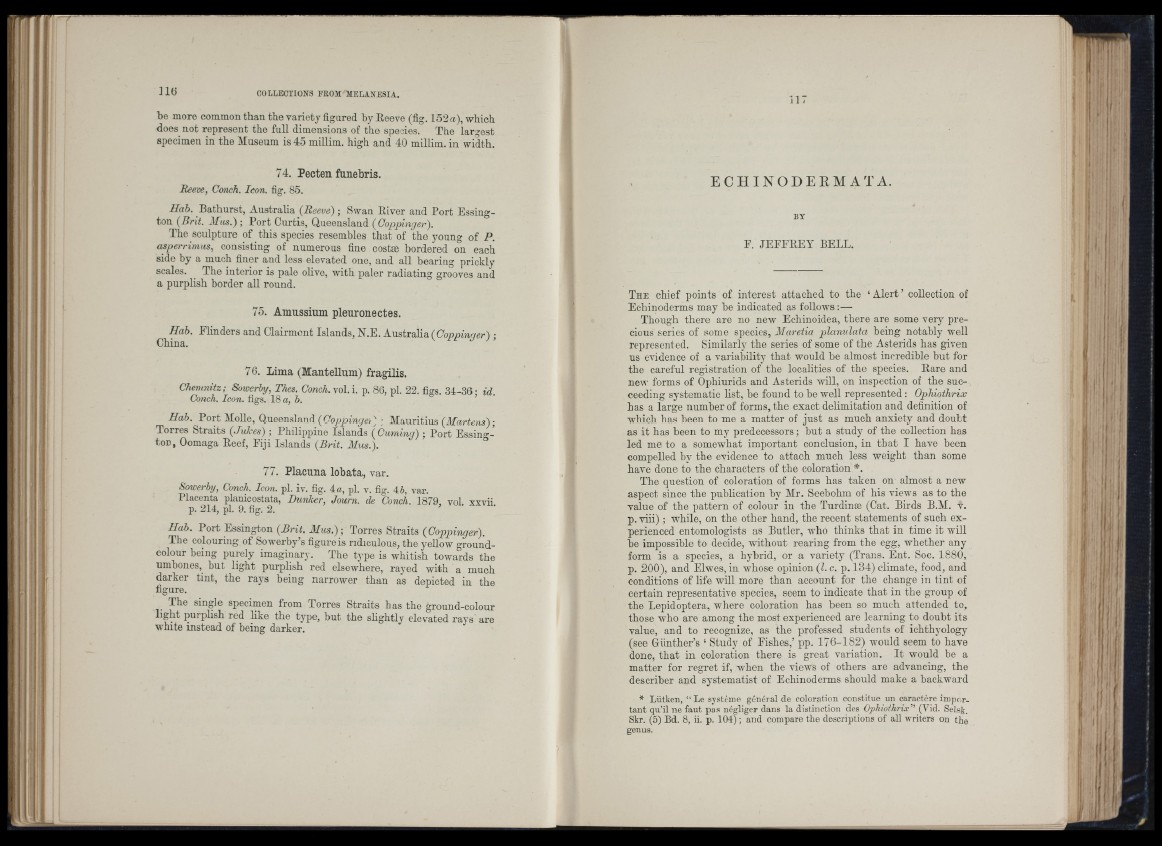
î
I
be more common than the variety figured by lleeve (fig. 152«), which
does not represent the full dimensions of tho spedes. The largest
specimen in the Museum is 45 millim. high and 40 millim. in width.
74. Pecten funehris.
Reeve, Conch. Icon. fig. 85.
Hah. Bathurst, Australia (toaeag) ; Swan Eiver and Port Essington
{Brit. Mas.) ; Port Curtis, Queensland {Copqnnger).
The sculpture of this species resembles that of the young of P.
asperrimus, consisting of numerous fine costæ bordered on each
side by a much finer and less elevated one, and all bearing prickly
scales. The interior is pale olive, with paler radiating grooves aud
a purplish border all round.
75. Amussium pleuronectes.
Ehnders and Clairmont Islands, N.E. Austraha {Coppinger) ;
76. Lima (Mantellum) fragilis.
Chemnitz; Sowerhy, Thes. Coneh. yol.i. p. 86, pi. 22. fio-g. 34-36 • id.
Conch. Icon. figs. 18 a, 6. ° ’ ’
Hah. Port Molle, Queensland ( ) ; Mauritius {Martens) ;
Torres Straits {Jukes) ; Philippine Islands {Cuming) ; Port Essing-
toD, Oomaga Reef, Eiji Islands {Brit. Mus.).
Placuna lobata, var.
Soiverhy, Conch. Icon. pi. iv. fig. 4 a, pi. v. fig. 46, var.
Placenta planicostata, Bunker, Journ. de Conch. 1879, vol. xxvii
p. 214, pi. 9. fig. 2.
Hah. Port Essington {Brit. Alus.); Torres Straits {Coppinger).
The colouring of Sowerby’s figuréis ridiculous, the yeUow groundcolour
being purely imaginary. The type is whitish towards the
umbones, hut light purplish red elsewhere, rayed with a much
darker tint, the rays being narrower than as depicted in the
figure.
The single specimen from Torres Straits has the ground-colour
h g h t purplish red hke the type, hut the shghtly elevated rays are
white instead of being darker.
t
IT
E CHI NOD E RMA T A .
BY
E. JEFEllEY BELL.
T h e chief points of interest attached to the ‘ Alert ’ collection of
Echinoderms may he indicated as follows :—
Though there are no new Echinoidea, there are some very precious
series of some species, Maretia planulata being notably well
represented. Similarly the series of some of the Asterids has given
us evidence of a variability th at would he almost incredible but for
the careful registration of the localities of the species. Rare and
new forms of Ophiurids and Asterids ivill, on inspection of the su e -.
ceeding systematic list, be found to he well represented : Opjliioihrix
has a large number of forms, the exact delimitation and definition of
which has been to me a matter of ju st as much anxiety and dou lt
as it has been to my predecessors ; hut a study of the collection has
led me to a somewhat important conclusion, in th at I have been
compelled bv the evidence to attach much less weight than some
have done to the characters of the coloration *.
The question of coloration of forms has taken on almost a new
aspect since the publication by Mr. Seebohm of his views as to the
value of the pattern of colour in the Turdinæ (Cat. Birds B.M. v.
p. viii) ; while, on the other hand, the recent statements of such experienced
entomologists as Butler, who thinks th at in time it will
be impossible to decide, without rearing from the egg, whether any
form is a species, a hybrid, or a variety (Trans. Ent. Soc. 1880,
p. 200), and Elwes, in whose opinion {I. c. p. 134) climate, food, and
conditions of life will more than account for the change in tin t of
certain representative species, seem to indicate that in the group of
the Lepidoptera, where coloration has been so much attended to,
those who are among the most experienced are learning to doubt its
value, and to recognize, as the professed students of ichthyology
(see Giinther’s ‘ Study of Fishes,’ pp. 176-182) would seem to have
done, th at in coloration there is great variation. I t would be a
matter for regret if, when the views of others are advancing, the
descriher and systematist of Echinoderms should make a backward
* Liitken, “ Le système général de coloration constitue un caractère important
qu’il ne faut pas négliger dans la distinction des Ophiothrix" (Vid. Sel.sk,
Skr. (5) Bd. 8, ii. p. 104) ; and compare the descriptions of all -writers on the
genus.
-
: i F
'■Mi
ÍTÍ
I
I
II i
. i f' I
li I •